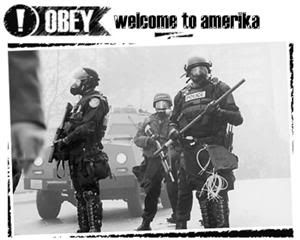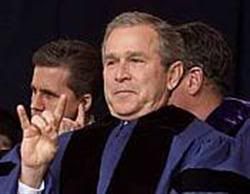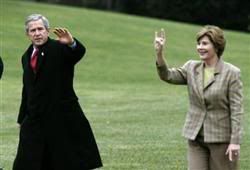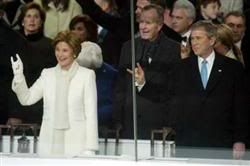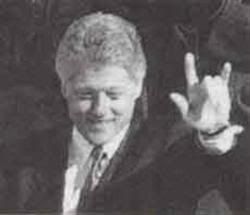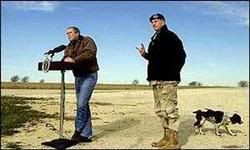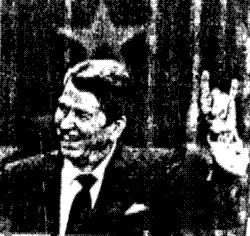US naval war games off the Iranian coastline: A provocation which could lead to War?
There is a massive concentration of US naval power in the Persian Gulf and the Arabian Sea. Three US naval strike groups off the Iranian coastline are deployed: USS Enterprise, USS Eisenhower and USS Iwo Jima Expeditionary Strike Group.
The naval strike groups have been assigned to fighting the "global war on terrorism."
Tehran considers the US war games to be conducted in the Persian Gulf, off the Iranian coastline as a provocation, which is intended to trigger a potential crisis and a situation of direct confrontation between US and Iranian naval forces in the Persian Gulf:
"Reports say the US-led naval exercises based near Bahrain will practise intercepting and searching ships carrying weapons of mass destruction and missiles.
Iran's official news agency IRNA quoted an unnamed foreign ministry official as describing the military manoeuvres as dangerous and suspicious.
Reports say the US-led naval exercises based near Bahrain will practise intercepting and searching ships carrying weapons of mass destruction and missiles.
The Iranian foreign ministry official said the US-led exercises were not in line with the security and stability of the region. Instead, they are aimed at fomenting crises, he said." (quoted in BBC, 23 October 2006)
USS Boxer Expeditionary Strike Group (ESG 5) to arrive in Arabian Sea
The USS Boxer (LHD 4), --which is the flagship for the Boxer Expeditionary Strike Group (ESG 5)-- which left Singapore on October 16, is scheduled to join the three naval strikes groups. ESG 5 is comprised of USS Boxer, Bunker Hill, USS Dubuque (LPD 8), USS Comstock (LSD 45), USS Benfold (DDG 65), and USS Howard (DDG 83). ESG 5 also includes PHIBRON 5, the 15th MEU, Coast Guard Cutter Midgett (WHEC 726).
“We are about to enter a part of the world that can be very dangerous,” said Chief Aviation Ordnanceman (AW/SW) Jacques Beaver, Boxer’s flight deck ordnance chief. “We must be flexible and prepared to defend ourselves from any threats.”
Boxer has been preparing for the weapons upload for two months by completing required maintenance and electronic pre-checks. Checks ensure that the ship’s missile and launching systems are up to standard and safe to load with live ordnance.
“It has taken a lot of hard work for our people to get this done,” said Chief Fire Controlman (SW) William Lewis, combat systems, fire control division’s leading chief petty officer. “You cannot measure the importance of having these defenses guarding the lives of the Sailors and Marines in this strike group.”
BOXESG is comprised of USS Boxer (LHD 4), USS Bunker Hill (CG 52), USS Dubuque (LPD 8), USS Comstock (LSD 45), USS Benfold (DDG 65) and USS Howard (DDG 83). The strike group also includes Amphibious Squadron 5, the 15th Marine Expeditionary Unit, Coast Guard Cutter Midgett (WHEC 726) and Canadian Frigate HMCS Ottawa (FFH 341).
BOXESG is currently conducting operations in support of the global war on terrorism while transiting to the Arabian
Gulf." (http://www.c7f.navy.mil/news/2006/october/3.htm)
Canada is part of the Expeditonary Strike Group (ESG 5)
Canada is formally participating in this military deployment under the disguise of the "war on terrorism". The Canadian Navy has dispatched Frigate HMCS Ottawa, which is now an integral part of ESG 5, under US Command. It is worth noting that particular emphasis has been given to medical evacuations and combat medical support suggesting that a combat scenario could be envisaged.
Boxer and Ottawa, both operating in the U.S. 7th Fleet area of responsibility, know that they can play a vital role to aid humanitarian assistance operations, medical evacuations or combat medical support that would rely heavily on the medical capabilities of the Boxer strike group. Cross training Sailors from ship to ship helps ensure the success of the strike group should BOXESG have to respond to any medical scenario, according to Richardson.
“Training is a necessary part of any evolution,” said Richardson. “Anytime you’re working with another nation, it’s important that we understand their capabilities just as much as they understand ours, so in the event anything occurs we know where our assets are.”
The cross training also fostered cooperation between the two allies which provided Verville and Boxer corpsmen a forum to learn about each other’s navies and each other’s culture." (Military.com October 2006)
Dangerous Crossroads: Tonkin II?
"An incident" in the Persian Gulf could be used by the US as a pretext for war against Iran.
A war pretext incident, similar to "the Gulf of Tonkin Incident", which triggered the Vietnam war, could be used by US forces, with a view to justifying retaliatory military action against Iran. In August 1964, President Lyndon B. Johnson claimed that North Vietnamese forces had attacked US destroyers in the Gulf of Tonkin. The Tonkin incident, which had been manipulated, contributed to unleashing a full-fledged war against Vietnam:
"A phantom attack on two U.S. destroyers cruising the Gulf of Tonkin was staged by the Pentagon and the C.I.A. The bogus attack occurred early in August, 1964. That evening President Lyndon Johnson went on television giving the grim details of the non-attack. Later, however, it was revealed that navy commander James Stockdale flew cover over the Gulf of Tonkin that night. Stockdale disclosed that U.S. ships were firing at phantom targets—targets that didn’t exist. The Gulf of Tonkin Incident that drew the U.S. into the quagmire of Viet Nam simply didn’t happen. Johnson, as presidents so often do, lied to the American people. The result was the rapid passage of the Gulf of Tonkin Resolution, which was the sole legal basis for the Viet Nam War. As a result of Johnson’s lie, three million Vietnamese people and fifty eight thousand U.S. soldiers died." (Charles Sullivan, Global Research, January 2006)
ANNEX: US NAVY
Navy Personnel
Active Duty: 349,783
Officers: 51,979
Enlisted: 293,368
Midshipmen: 4,436
Ready Reserve: 131,802 [As of 30 September]
Selected Reserves: 70,500
Individual Ready Reserve: 61,302
Reserves currently mobilized: 5,996 [As of 18 October]
Personnel on deployment: 36,037
Navy Department Civilian Employees: 175,454
Ships and Submarines
Deployable Battle Force Ships: 280
Ships Underway (away from homeport): 133 ships (47% of total)
On deployment: 104 ships (37% of total)
Attack submarines underway
(away from homeport): 22 submarines (40%)
On deployment: 11 submarines (20%)
Ships Underway
Carriers:
USS Kitty Hawk (CV 63) - Philippine Sea
USS Enterprise (CVN 65) - Persian Gulf
USS Nimitz (CVN 68) - Pacific Ocean
USS Dwight D.Eisenhower (CVN 69)- Mediterranean Sea
USS Ronald Reagan - Pacific Ocean
Iwo Jima Expeditionary Strike Group (ESG):
USS Iwo Jima (LHD 7) - Persian Gulf
USS Nashville (LPD 13) - Persian Gulf
USS Whidbey Island (LSD 41) - Persian Gulf
Boxer Expeditionary Strike Group (ESG):
USS Boxer (LHD 4) - Indian Ocean
USS Dubuque (LPD 8) - Indian Ocean
USS Comstock (LSD 45) - Indian Ocean
Essex Expeditionary Strike Group (ESG):
USS Essex (LHD 2) - South China Sea
USS Juneau (LPD 10) - South China Sea
USS Harpers Ferry (LSD 49) - South China Sea
Amphibious Warfare Ships:
USS Tarawa (LHA 1) - Pacific Ocean
USS Saipan (LHA 2) - Persian Gulf
USS Wasp (LHD 1) - port visit, Copenhagen, Denmark
USS Kearsarge (LHD 3) - Atlantic Ocean
USS Bataan (LHD 5) - Atlantic Ocean
USS Cleveland (LPD 7) - Pacific Ocean
USS Shreveport (LPD 12) - Atlantic Ocean
USS Ponce (LPD 15) - Atlantic Ocean
USS San Antonio (LPD 17) - Atlantic Ocean
USS Ashland (LSD 48) - Atlantic Ocean
USS Pearl Harbor (LSD 52) - Pacific Ocean
Aircraft (operational): 4000+
currently/or en route in/to Persian Gulf-Arabian Sea
(according to available information)



